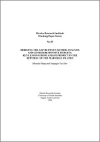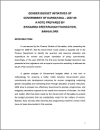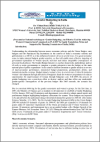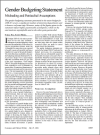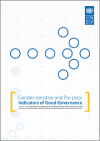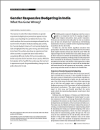FOUND 17 RESULTS
Due to gender discrimination and restrictive social roles, women and girls from ethnic minority groups in Viet Nam are particularly vulnerable to violence and discrimination. With financial support from the Government of Ireland, UN Women and the Committee for Ethnic Minority Affairs (CEMA) published a report on “Figures on Ethnic Minority Women and Men in Viet Nam 2015” presenting first-ever sex disaggregated data on the socio-economic situation of the 53 recognized ethnic...
This paper attempts to briefly examine the level of readiness/preparedness of Pacific Island countries (PICs) to advance the process of incorporating gender-responsive budget initiatives into national policies and public expenditure management systems. The paper touches on the "how to" mechanisms for progress based on the recommendations of the Ninth Triennial Conference of Pacific Women in 2004. It was jointly written by Suhas Joshi, Public Financial Management Advisor, the Pacific Financial...
The guide brings together and synthesises several innovative and tested strategies on gender responsive planning & implementation from across India....
This paper examines a GRB pilot project undertaken in the small Pacific country of the Republic of the Marshall Islands (RMI). This pilot project was conducted over a one-year budget cycle (September 2002-September 2003), and formed part of a regional technical assistance project funded by the Asian Development Bank. The technical assistance was provided by a University of South Australia (UniSA) consultancy team, comprising four advisors with expertise in gender, economics, policy and budgeting...
Following a commitment by the Finance Minister of Karnataka to create a separate cell in the Finance Department tasked with identifying the quantum and resource allocation and expenditure for women, the first ever Gender Budget document was presented in the year 2007-08 at the Legislature with a hope to improve the sensitivity to address the issues which concerns women.
In India, Gender budgeting as a distinct tool was institutionalized by the introduction of gender budgeting statement in the Union Budget 2005-06. This paper tries to trace the steps taken in this direction by analyzing the pattern of resource allocation under gender budgeting with an in-depth analysis of schemes included in Union Budget 2007-08.
Gender Budgeting in India by Dr. Vibhuti Patel was presented at a National workshop on Gender Budgeting: An Effective Tool for Achieving Women's Empowerment, organised on 15-4-2007 by Equity Foundation, Patna and Supported by Planning Commission of India, Delhi.
The article draws attention to the numerous assumptions relating to the proportion of allocations under a scheme that directly benefits women which unfortunately form the basis of the Gender Budgeting exercise. Several of these assumptions seem unrealistic and such unacceptable assumptions weaken the relevance of this particular Gender Budgeting exercise.
This paper was prepared as a background to the UNDP Oslo Governance Centre and Indian Council for Social Science Research (ICSSR) International workshop on engendering and empowering governance indicators, New Delhi, April 2005.
The article examines the two main strategies adopted by the Government of India for institutionalizing gender responsive budgeting to highlight what has gone wrong and what needs to be fixed in order to achieve better outcomes for women. This article by Yamini Mishra and Navanita Sinha was published in Economic and Political Weekly.



